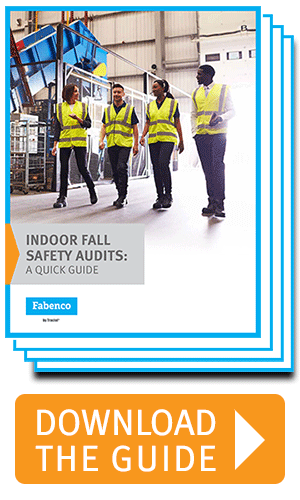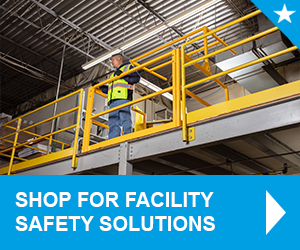
Providing the proper fall protection is one of the best ways you can safeguard the well-being of personnel and guests in any manufacturing facility. However, OSHA’s requirements for fall protection are continually evolving, and you may naturally wonder how you can best create a safe working environment at your company. Below are seven common questions on the OSHA requirements for fall protection.
1) “Why is fall protection such a major focus for OSHA?”
“Gravity doesn’t give you a second chance. If you fall and there is no effective fall protection in place, the result could end your career.”
– Jeffrey Erskine, Acting Deputy Regional Administrator for New England for OSHA
According to OSHA, falls are “among the most common causes of serious work related injuries.” Despite this finding, fall protection violations consistently rank at the top of OSHA’s top 10 list of most cited violations. In 2018, there were 7,270 fall protection violations, highlighting the need for facilities to increase their focus on coming into compliance with the OSHA requirements for fall protection. To provide a point of comparison, hazard communication violations, which rank second on OSHA’s list, accounted for significantly fewer violations, with 4,552 violations being found.
2) “Who is responsible for providing fall protection?”
The employer is ultimately responsible for safeguarding employees against falls and creating a safe environment for workers and visitors. Specifically, OSHA advises that, “Employers must set up the work place to prevent employees from falling off of overhead platforms, elevated work stations or into holes in the floor and walls.”
3) “Are there any areas of my facility that deserve special focus?”
Yes. While you should evaluate every part of your facility, there are some areas where the risk of falling is significantly higher than average. These areas deserve your sustained focus. They include the following:
- Loading docks: Approximately one in four warehouse injuries occurs on a loading dock. In many cases, employees or carriers fall from the loading dock while goods are being loaded or unloaded. Falls can also occur when delivery vehicles separate from loading docks.
- Mezzanines: As facilities grow and expand, they often use mezzanines to store inventory, tools, and other items. When mezzanines become overloaded with products and people, they become treacherous for employees and the risk of falls increases.
- Stairways: Fall risk is higher around stairways, especially those where visibility is limited or swing gates are not present. Poor stairway design can also put employees and visitors at an elevated risk of falls, outlining the need to evaluate the structural soundness of your stairways.
- Rooftops: In addition to dangers related to falls from the edge of a rooftop, facility rooftops often feature skylights, pits, and other holes that require swinging safety gates and other protective equipment.
4) “What elevations require fall protection?”
OSHA requirements for fall protection vary according to industry. For instance, fall protection is required at elevations of six feet within the construction industry while four feet is the standard within general industry workplaces. Employers are responsible for providing fall protection in accordance with the following elevations specified by OSHA:
“OSHA requires that fall protection be provided at elevations of four feet in general industry workplaces, five feet in shipyards, six feet in the construction industry and eight feet in longshoring operations.”
– Occupational Safety and Health Administration (OSHA)
5) “What equipment can help prevent falls within my facility?”
Additionally, installing swinging safety gates at your facility is another great measure you can take to prevent against falls. Self-closing swing gates provide an effective barrier for personnel in loading dock areas, stairwells, and mezzanines. Safety gates can also be customized to meet the specific needs of your facility.
6) “What happens if our facility does not have the proper fall protection?”
Failure to provide the proper fall protection can result in severe financial penalties for your business. And according to OSHA’s Fact Sheet on inspections, OSHA compliance officers also have the right to ask employers to “remove endangered employees” if a business fails to correct fall hazards, impacting productivity and workplace morale.
It is important to note that OSHA recently increased their financial penalties using a cost of living adjustment multiplier. These increases were outlined by OSHA in a memo distributed to regional administrators on January 23, 2019. The memo specifies that the new maximum penalty for a Serious violation is $13,260.00, representing an increase of $326 from 2018. Willful or repeated violations can result in fines of up to $132,598 per violation.
7) “What steps can safety managers take to avoid OSHA penalties?”
Adhering to OSHA requirements for fall protection is best achieved through a combination of employee education and use of OSHA-compliant swing gates. Here are some specific steps your organization can take to avoid OSHA penalties:
- Request a no-cost safety and health consultation with OSHA to learn about potential hazards and improve existing safety programs.
- Install OSHA-compliant swinging safety gates to help prevent falls in the high-risk areas outlined above.
- Remain abreast of the latest changes to OSHA fall protection requirements.
- Sign up for a comprehensive indoor fall safety audit.
The Bottom Line
Fall protection continues to be a major point of emphasis for OSHA. As a new safety manager or business owner, it is up to you to have a strong working knowledge of the latest OSHA fall protection requirements and to take the necessary steps to ensure that your facility complies with those requirements. OSHA-compliant safety gates play a key role in meeting these requirements and are available in a variety of models to suit your needs. When combined with a strong internal focus on fall prevention, safety gates can help you avoid OSHA penalties and reduce the number of injuries at your facility.






